I'm a technology content contributor with a background in Management Information Systems and a strong interest in cybersecurity and digital privacy. I specialize in creating practical, easy-to-understand guides about VPNs, privacy tools, and secure online practices to help users stay informed and protected in the digital age.https://safelyo.com/author/milliebobby/
Don't wanna be here? Send us removal request.
Text
Why Weave Breaks When VPN Is Active — And How to Actually Fix It
If your Weave app crashes the moment your VPN turns on, you’re not alone. This is a classic case of digital tools colliding: your VPN wants to encrypt everything, but Weave (whether it’s VoIP or Net) has strict networking needs that often get blocked in the process.
👨⚕️ If you're using Weave VoIP for your clinic or small business: The best fix is VPN split tunneling. It lets the Weave app bypass the encrypted tunnel while keeping all other internet traffic secure. You get full functionality without compromising privacy.
👨💻 If you're a Weave Net developer: Most of the time, the issue is a conflict in IP ranges. A quick --ipalloc-range adjustment at launch solves the problem. No more container traffic jams.
🎯 Additional Pro Tips:
Switch to a US/Canada VPN server to reduce latency
Open specific ports required by Weave
Switch VPN protocol to TCP for better reliability
We break down all these steps in plain English—with command examples and tool-specific walkthroughs.
🔗 Read the full guide and reclaim your workflow: https://safelyo.com/weave-not-working-when-vpn-is-on/
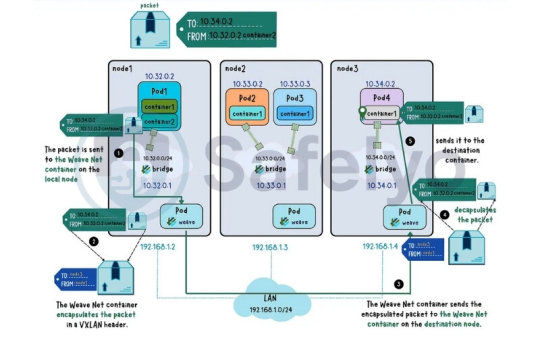
0 notes
Text
The "Almost Perfect" Tech Frustration: When Your GL.iNet VPN & Work Laptop Just Don't Click
You know that feeling? You've got your awesome GL.iNet router, your VPN is humming along, giving you that sweet, sweet security on unfamiliar networks. Everything's perfect… until you try to connect your work laptop. Silence. No internet. Utter frustration. 😩 It's like your tech setup is almost perfect, but that one crucial piece just refuses to cooperate.
If you've been searching for why your GL.iNet router and work laptop's VPN are battling it out, you're not alone. This "double VPN" conflict is incredibly common, and trust me, it's not a sign you're bad at tech. Your company laptop has its own corporate VPN, and your GL.iNet router is trying to put everything through its tunnel. They're both doing their job, just a bit too enthusiastically, leading to a traffic jam.
But here's the empowering news: the fix is built right into your GL.iNet router, hidden in plain sight! It's called "VPN Policy," and it acts like a super-smart traffic controller. You can tell your router, "Hey, for this one specific device – my work laptop – let it bypass your VPN. It needs its own direct line." This means your work laptop gets its dedicated, conflict-free connection, and all your other devices stay safe and sound under the router's VPN. It's truly the best of both worlds, turning that frustrating "almost perfect" into genuinely seamless. I've been there, solved it, and now you can too.
Ready to banish that tech headache and make your remote work life smoother? Our step-by-step guide will walk you through it.
2 notes
·
View notes
Text
🖥️ When Turning Off Your VPN is the Right Move
We always hear “Never go online without a VPN.” But what if your VPN is causing the issue?
Like:
A Zoom call that keeps freezing
Online banking login that won��t load
A sudden drop in download speed
💡 Sometimes, turning your VPN off is the solution—as long as you do it safely.
This step-by-step guide walks you through:
How to disable VPNs properly on Windows, macOS, and Linux
When it’s actually safe to disconnect
What risks to watch out for when your VPN is off
How to use features like “Pause” or “Snooze” instead of a full disconnect
🔐 Don't risk exposing your IP or personal data. Know when and how to do it right.
🔗 Read the full guide here: https://safelyo.com/how-to-turn-off-vpn-on-computer/
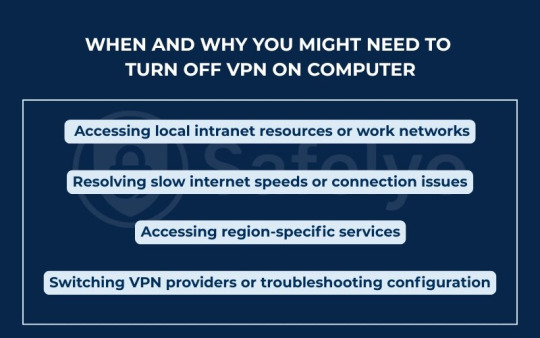
2 notes
·
View notes
Text
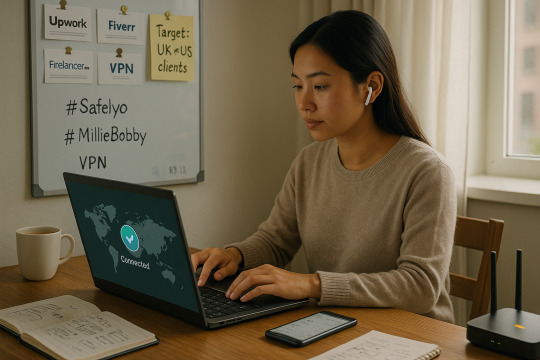
5 Strategic Ways Freelancers Can Use a VPN to Go Global
I still remember the first time I lost out on a client gig just because the platform didn’t support freelancers from my country. That’s when I discovered the real power of VPNs — not just for privacy, but for access.
As freelancers, our skills can reach across the world — but sometimes, the internet doesn't let us.
Here are 5 ways VPNs have helped me and fellow freelancers expand globally:
Access platforms like Toptal or FlexJobs that are region-locked
Match client time zones for better trust and sync
Preview international campaigns before they launch
Get better deals on tools by switching virtual locations
Work safely from coffee shops without fearing data leaks
VPNs aren’t a luxury — they’re a competitive edge.
🗺️ Borders don’t have to limit your work. Only your mindset can.
2 notes
·
View notes
Text
Why Your VPN Might Be Failing — And How VPN Passthrough Could Fix It
You did everything right: installed your VPN app, chose a server, hit connect—and still nothing. No connection, no error message, just a frustrating silence.
Here’s a little-known culprit that causes this exact problem: VPN passthrough.
This obscure router setting is critical if you’re using legacy VPN protocols like PPTP, L2TP, or IPsec. These older technologies don’t play nicely with NAT (Network Address Translation), which is how most home routers manage traffic. The result? Your encrypted traffic gets blocked, and the VPN tunnel fails to establish.
VPN passthrough exists to solve this issue. When enabled, it tells your router to allow certain types of encrypted traffic through—even if that traffic doesn’t follow the standard “port number” rules that NAT understands.
Why this matters today: Even in 2025, some companies and systems still rely on these legacy VPNs. If you’re working from home, supporting an older network setup, or using devices that rely on GRE or ESP traffic, knowing about passthrough can save hours of frustration.
But not everyone needs it.
Modern VPNs like OpenVPN, WireGuard, or IKEv2 with NAT-T are designed to work smoothly with NAT. In these cases, enabling passthrough won’t help—and might even add security risks.
If you're unsure whether VPN passthrough is necessary for your setup, Safelyo’s full guide covers: • How to check if it’s enabled • When to use it—and when not to • Steps for enabling it on routers from TP-Link, Asus, Netgear, and more • Modern VPN alternatives that avoid this issue entirely
It’s a practical guide, packed with examples and real-world troubleshooting tips.
👉 Dive into the full article here: https://safelyo.com/what-is-vpn-passthrough/
#VPNBasics #NetworkSecurity #MillieBobby #Safelyo #RouterSettings
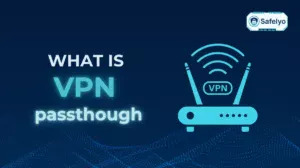
1 note
·
View note
Text
Why VPNs Are No Longer Optional for Professionals
A reflection on digital privacy in a connected world
In the age of remote work, digital nomads, and cloud-based everything, our online presence has become our professional identity. But while the benefits of this interconnected lifestyle are many, the risks are just as real.
A VPN (Virtual Private Network) is no longer just a tool for privacy-conscious developers or journalists—it’s now a must-have for anyone working across borders, platforms, or public networks.
Here’s why VPNs matter more than ever:
1. Secure Communication & Data Handling Whether you're accessing a client’s cloud dashboard or transferring sensitive financials, a VPN encrypts your connection, protecting it from eavesdropping and cyberattacks.
2. Remote Access Without Compromise Working from a coworking space in Bali? Logging in from a hotel room in Berlin? A VPN allows you to securely access your internal systems like you're sitting at HQ.
3. Geographic Freedom Need to review regional marketing content or access services blocked in your area? VPNs break down digital borders without breaking trust.
4. Compliance Is Not Optional If you work in fields like healthcare, legal, or finance, you’re already under pressure to follow privacy laws like GDPR or HIPAA. VPNs help you stay compliant—and stay employed.
But beyond the checklists and compliance, here’s the bigger picture: Using a VPN is a declaration—that you respect your clients, your collaborators, and your own digital footprint.
So if your work involves data, movement, or trust, it’s time to take VPNs seriously.
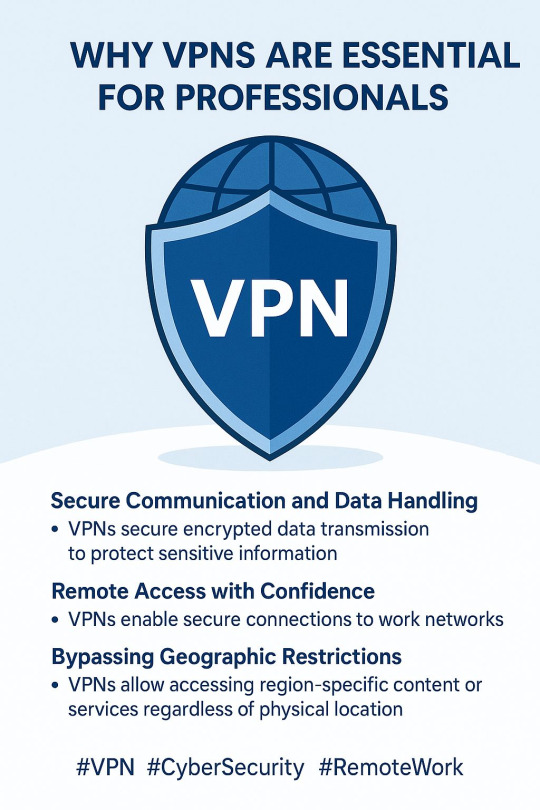
2 notes
·
View notes